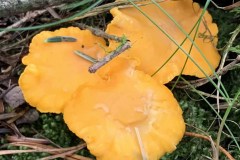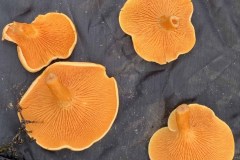Also known as the gold of the forest. The Chanterelle is one of the safest edible mushrooms to pick, as it shares no deadly lookalikes, however there is one lookalike that is not recommended to eat and may cause stomach upset.

It is perhaps somewhat superfluous to give a detailed description of chanterelles. After the fly agaric, it is the most familiar mushroom. Nevertheless, we want to delve into this mushroom as thoroughly as possible. The most useful part of this post will probably be how to distinguish between the chanterelle and the false chanterelle.
Description
Name: Chanterelle (Cantharellus cibarius)
Family: Cantharellus
Safe Mushroom: Among the five safe mushrooms, without deadly lookalikes.
Edible: Yes
Cap: Egg yolk/pale yellow/yellow/golden yellow in colour. To begin with it is vaulted with a rolled up edge, later it is shallowly funnel shaped. The margin of the cap is uneven and visible wavy. The surface of the cap is nice and smooth. 3-12cm.
Veins: The same colour as the cap, sometimes a little bit lighter. The veins are forked with cross-connections that are long, deep and descending. There isn’t a clear boundary between the folds and the stem. The folds can be deep to the point that they look like gills, especially in the older specimens.
Spore Pint: Light yellow
Stem: Same colour as the cap or slightly lighter. The stem is smooth and somewhat funnel shaped. 3-10cm in height and 5-10cm in thickness.
Whole Mushroom: When damaged can get brownish spots.
Flesh: White or slightly yellowish. Firm and rarely eaten by worms.
Smell: Extremely pleasant, smells like apricots.
Taste: A little bit peppery when raw (this disappears once cooked). It has a lovely stand alone taste, so it may be recommended to not mix this mushroom with other strong tasting mushrooms e.g. boletes or portobellos .
Habitat: Can grow in small or large groups. Form mycorrhiza with various types of trees and is found in almost all types of forests, including but not exclusive to mountain birch forests. Often grows in rows or arches. Can be found on trails and along the road. Notoriously difficult to spot when growing in a mossy area. It has been said that they like where the sun shines in the morning. Needs a moist environment over time to grow well. Hence why you can often find large quantities of them after a humid and cold summer.
Distribution: Quite common across Europe.
Season: Early summer till late Autumn.
Use: Fry amazingly with butter or oil any oil of choice. Has a strong taste, so avoid using with other strong mushrooms. Some people believe they are spoiled when dried, however we have personally not had this problem.
Confusion: Similar to the false chanterelle, please see the images below. May be confused for other yellow mushrooms, but very unlikely.
False Chanterelle

The false chanterelle (Hygrophoropsis aurantiaca) can be extremely similar to the chanterelle, even though they are are not related at all. The genus Hygrophoropsis is actually more closely related to pored boletes, that are known to contain dangerous toxins. For this reason it is believed that the false chanterelle may also contain these toxins (Egeland, 2011), however no research so far has been able to prove this theory (Egeland, 2012). It has however been noted to cause mild gastrointestinal trouble, but definitely not deadly. According to wikipedia this may be due to the large amounts of the sugar alcohol arbitol. Some have even noted that the mushroom doesn’t taste bad to eat, however consensus says it isn’t a good edible.
Main Differences:
The false chanterelle is a saprotrophic fungus, meaning that it lives off dead plant material, whereas the chanterelle is a mycorrhizal fungus. The false chanterelle has gills as opposed to the veins present on a chanterelle. These gills are often a brighter colour than that of their cap. Furthermore, the false chanterelle is orange inside and often hollow.
Differences between the chanterelle and the false chanterelle:
| False Chanterelle Hygrophoropsis aurantiaca | Chanterelle Cantharellus cibarius |
|---|---|
| Colour: More orange, lighter or darker | Colour: Egg yolk, pale yellow, yellow and golden yellow |
| Cap: Dry, matt, similar to suede. | Cap: Smooth |

| Gills: Orange, thin and densely packed together. Decurrent. | Gills: No gills, but veins. Visibly thick and extend down to the stem (decurrent). |
| Stem: Thinner and taller than chanterelles and often hollow. | Stem: 3-10 cm in height, 5-10 mm in width. White flesh inside |

| Flesh: Soft and orange | Flesh: Firm and yellow/white inside. |
| Habitat: Common. Likes dry seasons and grows well on old tree stumps, in particular spruce. | Habitat: Common. Grows best in a moist environment. |
The images in this port are released under license: CC BY 4.0
Sources
Gulden, G. (2018) Soppboka. Oslo: Cappelen Damm
Egeland, I. L. (2011) Norske Sopper. Oslo: Gyldendal
Egeland, I. L. (2012) Sikre Sopper. Oslo: Gyldendal
Dann, G. (2017) Edible Mushrooms. UIT Cambridge Ltd
Falk, L. (1981) Skogens spisskammer. Stokkholm: Atlantis
Ryvarden, L. (2010) Norske matsopper. Oslo: Cappelen Damm
https://en.wikipedia.org/wiki/Hygrophoropsis_aurantiaca
https://www.first-nature.com/fungi/cantharellus-cibarius.php














